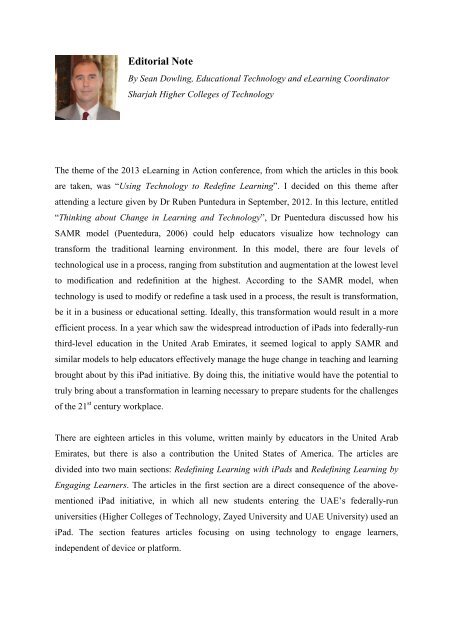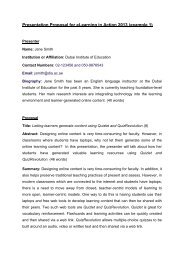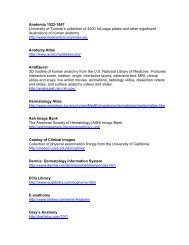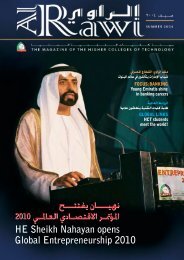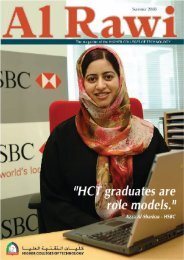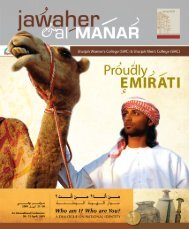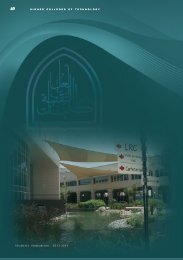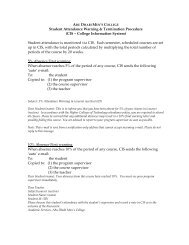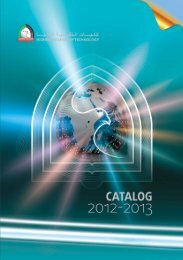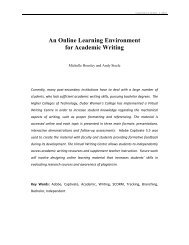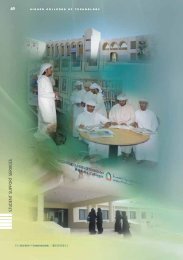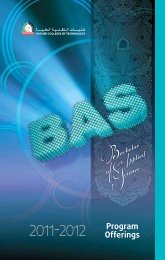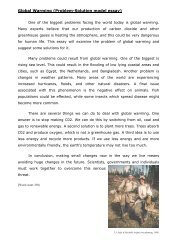Editorial Note - Sharjah Women's College - Higher Colleges of ...
Editorial Note - Sharjah Women's College - Higher Colleges of ...
Editorial Note - Sharjah Women's College - Higher Colleges of ...
You also want an ePaper? Increase the reach of your titles
YUMPU automatically turns print PDFs into web optimized ePapers that Google loves.
<strong>Editorial</strong> <strong>Note</strong>By Sean Dowling, Educational Technology and eLearning Coordinator<strong>Sharjah</strong> <strong>Higher</strong> <strong>College</strong>s <strong>of</strong> TechnologyThe theme <strong>of</strong> the 2013 eLearning in Action conference, from which the articles in this bookare taken, was “Using Technology to Redefine Learning”. I decided on this theme afterattending a lecture given by Dr Ruben Puntedura in September, 2012. In this lecture, entitled“Thinking about Change in Learning and Technology”, Dr Puentedura discussed how hisSAMR model (Puentedura, 2006) could help educators visualize how technology cantransform the traditional learning environment. In this model, there are four levels <strong>of</strong>technological use in a process, ranging from substitution and augmentation at the lowest levelto modification and redefinition at the highest. According to the SAMR model, whentechnology is used to modify or redefine a task used in a process, the result is transformation,be it in a business or educational setting. Ideally, this transformation would result in a moreefficient process. In a year which saw the widespread introduction <strong>of</strong> iPads into federally-runthird-level education in the United Arab Emirates, it seemed logical to apply SAMR andsimilar models to help educators effectively manage the huge change in teaching and learningbrought about by this iPad initiative. By doing this, the initiative would have the potential totruly bring about a transformation in learning necessary to prepare students for the challenges<strong>of</strong> the 21 st century workplace.There are eighteen articles in this volume, written mainly by educators in the United ArabEmirates, but there is also a contribution the United States <strong>of</strong> America. The articles aredivided into two main sections: Redefining Learning with iPads and Redefining Learning byEngaging Learners. The articles in the first section are a direct consequence <strong>of</strong> the abovementionediPad initiative, in which all new students entering the UAE’s federally-rununiversities (<strong>Higher</strong> <strong>College</strong>s <strong>of</strong> Technology, Zayed University and UAE University) used aniPad. The section features articles focusing on using technology to engage learners,independent <strong>of</strong> device or platform.
Section One: Redefining Learning with iPadsIn the opening article, iPads as Cognitive Toolboxes in <strong>Higher</strong> Education, Dr CathyCavanaugh and Dr Jace Hargis discuss the current opearation <strong>of</strong> the iPad programme at the<strong>Higher</strong> <strong>College</strong>s <strong>of</strong> Technology in the UAE and the resultant learning ecosystem. In thisecosystem, the learner and instructor are central and success is built on effective use <strong>of</strong> thetechnology (iPads) as a customized cognitive toolbox. They explain in detail how sixcomponents <strong>of</strong> cognitive tools are aligned with the iPad programme.In his article, Up To The Task: Task Based Learning with iPads, Jesse Balanyk discusses theimplementation <strong>of</strong> iPads within a task-based learning framework in a preparatory Englishlanguage programme at the United Arab Emirates University. He explains how iPad-basedactivities, when grounded on sound pedagogical principles, and employing the uniquecapacities <strong>of</strong> the iPad, increase engagement and motivation among lower-level languagestudents. To demonstrate this, the article describes in detail an iPad-based lesson. This lessonin then analysed to show how it fits within the SAMR framework.In Blending Health and Physical Education with Technology, Susan Carter describes howthe Health and Physical Education (HAPE) faculty <strong>of</strong> the Dubai <strong>Higher</strong> <strong>College</strong>s <strong>of</strong>Technology have redefined health and physical education learning through the introduction<strong>of</strong> the iShape programme, a blend <strong>of</strong> innovative technologies such as iPads, iBooks, fitnessapplications, blood pressure monitors, weighing scales and advanced pedometers (FitBit).The theory behind the programme, the Fogg Behavior Model, is also discussed in detail.Richard Taylor, in Designing an iBook for IELTS Writing Practice, outlines the reasonswhy a significant number <strong>of</strong> students fail to achieve the required IELTS band. He describeshow an iPad resource has been used in the foundations’ programme at <strong>Sharjah</strong> Men’s<strong>College</strong>, HCT, with the aim <strong>of</strong> decreasing the failure rate. This resource has been specificallydesigned to help students practice report writing, a key skill needed for the IELTS writingexam. In the article, the aims <strong>of</strong> the resource, the activities included, the workflow and how itcan be used in class are described.In Students Constructing iBooks for Students: Student-centered Materials Development, AliFarhat and Dr John Raven describe a project incorporating social constructivist bestpractices whereby senior student build iBooks for foundations level classes at the <strong>Sharjah</strong><strong>Higher</strong> <strong>College</strong>s <strong>of</strong> Technology. The article shows examples <strong>of</strong> these iBooks, provides
feedback from both the student iBook constuctors and the recipients and discusses theimplications for further development <strong>of</strong> iBooks.In their article, Substitution to Redefinition: The Challenges <strong>of</strong> Using Technology, GeraldineChell and Sean Dowling describe how the iPad initiative at Federal Institutions in the UAEhas been introduced to give students more opportunities to develop 21 st century skills anddigital media literacy. They discuss in detail how iPad apps have been used as part <strong>of</strong> thisinitiative and how they fit into the Puntedura’s SAMR model, and <strong>of</strong>fer some furthersuggestions as to how the best make the iPad a tool for learning transformation.Helen Donaghue, Margot Lange and Rachel Scott, in Reflecting on Mobile Learning: ACommunity <strong>of</strong> Practice Approach, describe a community <strong>of</strong> practice (CoP) at <strong>Sharjah</strong> Men’s<strong>College</strong>, HCT, that was used to support foundations-level teachers quickly become efficientiPads users. The CoP encouraged teacher learning and the participants met regularly to reflecton, share experiences <strong>of</strong>, and share best practice in the pedagogical use <strong>of</strong> iPads. The articlealso reports on data results from recording <strong>of</strong> meetings with CoP participants.In the final article <strong>of</strong> the section, Use <strong>of</strong> Technology in the Mathematics Classroom: the WayForward, Dr Mohammed Goma Tanko looks at research carried out in the Foundationsprogramme at Abu Dhabi Women’s <strong>College</strong>, HCT, in which students appeared moremotivated to use mathematics when the doing projects relevant to their everyday lives. Hethen applies the implications <strong>of</strong> this research to his current work environment, Fujairah Men’s<strong>College</strong>, HCT, and suggests ways in which student motivation levels can be further increasedby the use <strong>of</strong> iPads in mathematics projects.Section Two: Redefining Learning by Engaging LearnersIn iTunes, YouTube and Me: Augmenting your Classroom, Dr Paul Beaudoin discusses thearrival <strong>of</strong> the “digital native” in our classrooms and the need for educators trained in usingdigital and web-based tools. The article also outlines several practical strategies developed inPaul’s online classes that educators can use to expand and enhance any 21 st centuryclassroom.In her article, Learning with Digital Narratives and Social Media Tools, Baa’ra Yousefdescribes an action research initiative, “Discussed Digital Narratives”, done at Dubai Men’sCampus, HCT. Key educational trends, mainly dealing with equipping students with skills
equired for the future job market, are outlined. There is also a detailed discussion on howdigital narratives and social media tools have been used to put some put some keyeducational trends into action and positively contribute to increasing students’ readiness fortheir future jobs.Guy Stieglitz, in The Readingcast: An Effective Tool to Raise Awareness <strong>of</strong> ReadingStrategies, discusses how readingcasts were used in the introductory Reading and Writingcourse <strong>of</strong> the Bachelor <strong>of</strong> Education Program at Fujairah Women’s <strong>College</strong>, HCT. Guyoutlines how readingcasts are a simple, effective tool that can be used to promotemetacognitive awareness <strong>of</strong> reading strategies. The importance <strong>of</strong> screencasting and therelevance <strong>of</strong> reading strategies, followed by the implementation process, and the benefits <strong>of</strong>readingcasts are discussed in detail.In the next article, PODIO: Work with Anyone from Anywhere!, Tamilselvan Mahalingamand Cynthia Ogilvy write about using PODIO, an online collaborative work platform tomanage team projects. The article describes how students, by using PODIO, can work theway they want, where they want. There is a detailed description <strong>of</strong> how PODIO has beenadopted for to manage group projects and online collaboration for a business course at theDubai Women’s <strong>College</strong>, HCT.In Student Engagement using Micros<strong>of</strong>t Interactive Classroom - Advanced ClassroomTechnology, Dr Damodharan Varadarajan and Priya Lakshmi Narasimhan discuss aMicros<strong>of</strong>t Interactive Classroom (MIC) project that was used in the Business Faculty atDubai Women’s <strong>College</strong>, HCT. In this project, a range <strong>of</strong> technologies that help to enhancethe collaborative learning experience in the classroom. The article describes a learningmanagement system which enhances classroom presentations by increasing studentparticipation, helping teachers assess student comprehension, and helping in activeengagement <strong>of</strong> students in the classroom.In his article, Communities <strong>of</strong> Inquiry and Assessment: Graded Discussions, Paul Lesliewrites about the community <strong>of</strong> inquiry model which suggests that three ‘presences’ arerequired in any group interaction in order to facilitate knowledge construction. The articlecontains a study, done at <strong>Sharjah</strong> Women’s <strong>College</strong>, HCT, <strong>of</strong> three discussion boardassignments and attempts to correlate the experience and exposure the participants have hadto the community <strong>of</strong> inquiry model with the quality <strong>of</strong> the discussion board interactions. It
then asks if the quality <strong>of</strong> the exchanges between participants can be improved throughinstruction and familiarity with the model.Nafees Sultana and Dr Simon Hayhoe, in Assistive Technology for Students with SpecialNeeds, describes how Assistive Technologies (AT) currently used at the <strong>Higher</strong> <strong>College</strong> <strong>of</strong>Technology. The article reviews a number <strong>of</strong> learning difficulties and physical disabilitiesand identifies possible technological. In the course <strong>of</strong> the discussion, learning strategies arealso discussed as a result <strong>of</strong> the introduction <strong>of</strong> AT. Finally, ways in which students withspecial needs can participate in a significant majority <strong>of</strong> educational tasks is outlined.In The Evolution <strong>of</strong> Teaching Project Management, David Carter discusses how coursesdelivered with one-delivery approaches can be a barrier to open learning as they areconstrained to the classroom, accessible only during a class and teacher centric. This articledescribes how the SAMR model can examine practical ways to allow technology to directlysubstitute existing practices, augmenting, modifying and finally redefining teaching practicesand the use <strong>of</strong> educational technology – starting with the PowerPoint slide.In the article, Training Teachers in Web2.0 Tools for Teaching and Learning EFL, VanceStevens describes how a course using Web 2.0 tools to exploit an individual laptopenvironment, originally designed and successfully implemented for students in the UAE navycollege, became a basis for training teachers at the aviation college in using the same toolsand rationale toward mounting similar courses there. The article concludes with a report onhow the teachers responded to the blended environment used for their training.In the final article, Positive-Activity in Blended-Learning, Dr Michelle Estable-Rogershighlights some <strong>of</strong> the research and methods centered on positive emotion activitiesand tactics that support student success in education. She describes how by usingvarious educational technology tools, these positive-activity methods can be integratedinto blended-learning courses such that a teacher can actively promote studentpositivity in the classroom and subsequently foster higher student achievement.References
Puentedura, R. (2006). Transformatiom, Technology, and Education. Presentation givenAugust 18, 2006 as part <strong>of</strong> the Strengthening Your District Through Technologyworkshops, Maine, US. Retrieved from http://hippasus.com/resources/tte/part1.html.Puentedura, R. (2011): Thinking About Change in Learning and Technology. Presentationgiven September 25, 2012 at the 1 st Global Mobile Learning Conference, Al Ain, UAE.Retrieved fromhttp://www.hippasus.com/rrpweblog/archives/2012/04/10/iPad_Intro.pdf.


